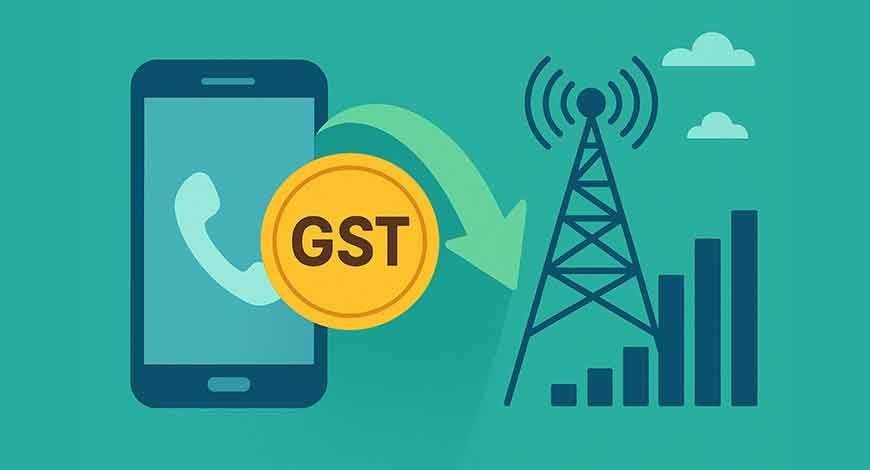In today’s hyperconnected world, affordable communication is no longer a luxury—it’s a necessity. For India, a country with over a billion mobile connections and the world’s second-largest internet user base, ensuring affordable connectivity is central to its digital growth story. The recent announcement of Goods and Services Tax (GST) cuts on telecom services is being seen as a major step toward this goal.
The government’s rationalization of GST rates for telecom services is designed to reduce the burden on consumers, help telecom operators expand services, and push forward the Digital India vision. By making communication cheaper, policymakers hope to bridge the digital divide and enable broader participation in the country’s fast-growing digital economy.
Why GST Cuts Matter for Telecom
Telecom services have long been taxed heavily in India. Before GST rationalization, consumers often complained that high indirect taxes made services like mobile calls and internet data more expensive, especially when compared to other developing countries.
By cutting GST rates, the government:
- Reduces the effective cost of mobile recharges, data packs, and call services.
- Makes broadband and digital services more accessible to lower-income groups.
- Provides relief to telecom operators who are struggling with high spectrum fees and debt.
This policy is not just about cheaper phone bills—it is about making communication a universal right in a digital-first India.
The Consumer Impact
For millions of Indians, especially those in rural and semi-urban areas, even a small reduction in monthly telecom expenses makes a huge difference.
Direct Benefits:
- Cheaper Mobile Data: With India being the largest consumer of mobile data globally, lower GST means internet services become more affordable for the masses.
- Affordable Call Charges: Lower taxation on voice services ensures that traditional calling remains within reach for all.
- Reduced Digital Divide: Rural households and students benefit the most, as cheaper communication enhances access to online education, telemedicine, and e-governance.
In a country where average monthly ARPU (average revenue per user) is among the lowest in the world, affordability plays a decisive role in adoption.
Telecom Industry Perspective
India’s telecom operators—Reliance Jio, Bharti Airtel, and Vodafone Idea—have long been lobbying for GST relief. The industry has been facing immense financial stress, with high spectrum costs, regulatory dues, and debt burdens.
How GST Cuts Help Operators:
- Higher Subscriber Retention: Lower costs reduce churn rates and keep customers on board.
- Increased Data Consumption: Affordable pricing encourages more usage, indirectly boosting revenues.
- Support for 5G Rollout: Cost relief frees up resources for faster investments in next-generation networks.
- Operational Stability: Reduced tax outflows improve overall financial health.
Thus, the GST move is not just consumer-friendly—it also stabilizes one of India’s most critical industries.
Digital India and Inclusion Goals
India’s Digital India mission envisions a country where every citizen can access digital services—from online banking to e-governance—without barriers. Affordable telecom is the foundation of this vision.
GST Cuts Will:
- Boost digital literacy by bringing more first-time users online.
- Encourage SMEs and startups to leverage cheaper digital communication tools.
- Expand the reach of edtech and healthtech platforms in smaller towns.
- Support the government’s push for cashless transactions and digital payments.
In short, cheaper communication drives economic growth, innovation, and social inclusion.
International Comparison
Globally, affordable telecom has been a priority for developing nations:
- Countries like Indonesia and Kenya reduced telecom taxes to boost digital inclusion.
- The European Union has emphasized reducing indirect taxes on connectivity to meet broadband targets.
- India’s move aligns with these global best practices, positioning it as a leader in making communication both affordable and accessible.
Challenges Ahead
While GST cuts are a welcome relief, challenges remain:
- Sustainability of Telecom Business Models: Operators still face intense competition and thin profit margins.
- Rural Connectivity Gaps: Lower prices must be matched by infrastructure expansion in remote areas.
- 5G Rollout Costs: Operators will need additional government support to meet the capital-intensive demands of 5G.
- Policy Consistency: Long-term regulatory clarity is essential to ensure stability in pricing.
Without addressing these, GST cuts alone may not fully resolve affordability concerns.
Expert Reactions
- Industry Analysts: Believe the move will accelerate subscriber growth and boost adoption of digital services.
- Consumer Advocates: Welcome the relief but urge operators to pass on the full benefit to end-users.
- Telecom Operators: Call it a “timely reform” that supports both industry survival and consumer welfare.
Overall, sentiment across stakeholders remains positive, with a shared belief that cheaper communication will boost India’s digital economy.
Outlook for the Future
Looking forward, the GST rationalization could pave the way for broader reforms:
- Integration with BharatNet: Cheaper services combined with rural broadband expansion could transform rural India.
- Increased Internet Penetration: With over 800 million internet users today, the goal of crossing 1 billion users is now closer than ever.
- Boost to 5G Adoption: Lower communication costs may accelerate consumer adoption of 5G-enabled services.
- Strengthening India’s Digital Economy: As more citizens come online, sectors like fintech, e-commerce, and digital services will thrive.
The GST cut is not just a tax change—it’s a strategic push to democratize access to communication.
Conclusion
The GST cuts on telecom services mark an important step in India’s journey toward universal, affordable communication. By reducing consumer costs, easing industry stress, and supporting digital inclusion, the reform aligns perfectly with the government’s long-term vision of a digitally empowered society.
For consumers, it means cheaper bills. For telecom operators, it means breathing space. For India as a whole, it represents progress toward bridging the digital divide and ensuring that communication truly becomes a right for all, not a privilege for few.
The NewsBit Bureau
